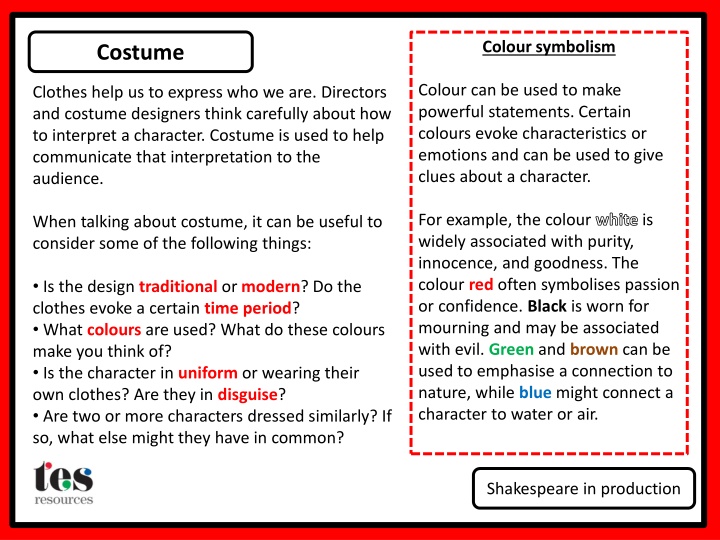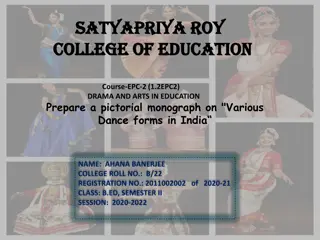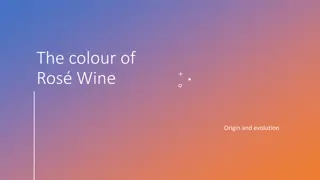"Colour Symbolism in Costumes: Making Powerful Statements"
Exploring the significance of color in costume design can reveal hidden depths to a character. Colors carry symbolic meanings that can convey emotions, traits, and narratives, subtly shaping the viewer's perception. By skillfully incorporating colors into costumes, designers can enhance storytelling and character development, adding layers of complexity and richness to the visual storytelling experience. Understanding the language of color in costumes enables creators to make intentional choices that resonate with audiences on a subconscious level, enhancing the overall impact of a production.
Download Presentation

Please find below an Image/Link to download the presentation.
The content on the website is provided AS IS for your information and personal use only. It may not be sold, licensed, or shared on other websites without obtaining consent from the author.If you encounter any issues during the download, it is possible that the publisher has removed the file from their server.
You are allowed to download the files provided on this website for personal or commercial use, subject to the condition that they are used lawfully. All files are the property of their respective owners.
The content on the website is provided AS IS for your information and personal use only. It may not be sold, licensed, or shared on other websites without obtaining consent from the author.
E N D
Presentation Transcript
Colour symbolism Costume Colour can be used to make powerful statements. Certain colours evoke characteristics or emotions and can be used to give clues about a character. Clothes help us to express who we are. Directors and costume designers think carefully about how to interpret a character. Costume is used to help communicate that interpretation to the audience. For example, the colour white is widely associated with purity, innocence, and goodness. The colour red often symbolises passion or confidence. Black is worn for mourning and may be associated with evil. Green and brown can be used to emphasise a connection to nature, while blue might connect a character to water or air. When talking about costume, it can be useful to consider some of the following things: Is the design traditional or modern? Do the clothes evoke a certain time period? What colours are used? What do these colours make you think of? Is the character in uniform or wearing their own clothes? Are they in disguise? Are two or more characters dressed similarly? If so, what else might they have in common? Shakespeare in production
Set design and props Looking for symbols A set is used to communicate the mood or atmosphere of a play, but it also needs to be functional. Set design must allow enough space for all of the action to take place and must accommodate any special features required by the script, such as trap doors, balconies or staircases. Objects on the stage may be symbolic. This means that they stand for or represent something. This could be an abstract concept, such as love, which we cannot physically touch. For example, a bird in flight might symbolise freedom, while a skull can represent death or danger. A set may evoke a certain time period, location or design movement. It may be realistic or abstract. Making sense of symbols can give us clues to the themes of the play and help us to gain a deeper understanding than if we only pay attention to the dialogue. Objects used on stage are called props. Very few props were used in Shakespeare s time. However, there are certain items, such as swords, daggers and letters, that are essential to the plot. Shakespeare in production
Through the camera lens Technical elements Film directors make use of different camera shots and movements to direct the viewer s attention. The technical elements of a production include lighting, special effects and music. Long shot: The subject of the shot takes up most of the frame height. Mid shot: Shot from medium distance, shows part of the subject but gives the impression of showing the whole. Close up: One part of the subject takes up most of the frame. Used to emphasise details. Pan: Camera moves horizontally left or right from a fixed point. Tilt: Camera moves vertically up or down from a fixed point. Tracking: The camera is not fixed, but travels to follow an actor or action. Zooming: A refocusing of the camera lens to give the illusion of moving closer to or further away from something. In Shakespeare s time, these were more limited than they are today. Sound effects were created by musicians and occasionally a cannon would be used. All music was performed live on stage. Today, much more complicated effects can be achieved, especially in film. These can make a scene appear more real or more vivid. Music is still an important part of many productions. Shakespeare in production
Interpretation Inspired by Shakespeare Any production of Shakespeare will be a unique interpretation of his work. This means that the director will be conveying his or her own understanding of Shakespeare s ideas. Directors may also attempt to communicate a social or political message. Sometimes, adaptations of Shakespeare can stretch the limits of interpretation. Here are some examples of films that use one of his plays as the basis for something new: The Lion King (1994) based on Hamlet. West Side Story (1961) based on Romeo and Juliet. She s the Man (2006) based on Twelfth Night. 10 Things I Hate About You (1999) based on The Taming of the Shrew. Forbidden Planet (1956) based on The Tempest. Characters and their motivations are often open to interpretation. Where one director might want to emphasise the negative traits of a character, another may choose to present the same character more sympathetically. This can be achieved by cutting parts of the script and through costume choice. The way that an actor delivers lines or reacts to the performances of other actors is also important. Shakespeare in production
New perspectives Audience response When you are considering the different ways in which an audience might respond to a production, it can be useful to put yourself in somebody else s shoes. It is important to remember that the director is not the only one who has a unique interpretation. Members of the audience will also have their own personal understanding of what they see. Consider a viewer who is older than you, who may already be married or have children. Think about how a feminist might react. Would your response have been different if you lived in Elizabethan England? Think about someone of a different sexuality or race to you. Might they be offended by any part of the production? How you interpret or react to a play can depend on factors such as your age, gender, race and political views. The time and the place you live in will also have an impact on how you respond. For example, things that might appear sexist or racist to audiences today may not have seemed problematic to a Shakespearean audience, who would have considered the same material to be normal, or even funny. Shakespeare in production























